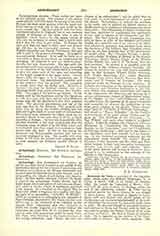

Archaeology, THE COMMISSION OF SACRED, an official pontifical board founded in the middle of the nineteenth century for the purpose of promoting and directing excavations in the Roman Catacombs and on other sites of Christian antiquarian interest, and of safeguarding the objects found during such excavations. At that period Giovanni Battista De Rossi, a pupil of the archaeologist Father Marchi, had already begun the investigation of subterranean Rome, and achieved results which, if confirmed, promised a rich reward. In a vineyard on the Appian Way he discovered (1849) a fragment of a marble slab bearing part of an inscription, “NELIVS. MARTYR”, which he recognized as belonging to the sepulchre of Pope Cornelius, martyred in 253, whose remains were laid to rest in the Catacomb of St. Callixtus on the Appian Way. Concluding that the vineyard in which the marble fragment was found overlay this Catacomb, he urged Pius IX to purchase the vineyard in order that excavations might be made there. The Pope, after listening to the representations of the young enthusiast, said: “These are but the dreams of an archaeologist”; and he added that he had works of more importance on which to spend his money. Nevertheless, he ordered the purchase to be made, and he allotted an annual revenue of 18,000 francs to be applied for excavations and future discoveries. The Commission of Sacred Archology was then appointed to superintend the application of this fund to labors in the Catacombs and elsewhere. The first meeting of this Commission was held at Rome at 1851, at the residence of Cardinal Patrizi, who presided over it by virtue of his office, and selected its members, first amongst them being the Sacristan of His Holiness, Msgr. Castellani, whose office up till then included that of the preservation of sacred relics. Msgr. Vincenzo Tizzani, a distinguished scholar, Professor of History in the Roman University; Marino Marini, Canon of St. Peter’s; Father Marchi, S.J., and G. B. De Rossi, were the first members. At present it is presided over by the Vicar of His Holiness, Cardinal Respighi, and among its members are such well known archaeologists as Msgr. Giuseppe Wilpert, Father Germano, C.P., Father Bonavenia, S.J., Orazio Marucchi, Giuseppe Gatti, Baron Rodolfo Kanzler, Msgr. Stornaiolo, and P. Franchi de’ Cavalieri. The work achieved under its direction is very extensive. It includes the formation of the Museum of Catacomb Inscriptions and Christian Antiquities in the Lateran Palace; the enormous excavations and repairs in the Catacombs; the discovery and opening up of several subterranean chapels of third-century popes, of St. Cecilia, of the Acilii-Glabriones, and the Cappella Greca; the opening up of many Catacombs now accessible to visitors; the publication of the three great volumes of De Rossi’s “Roma Sotteranea” and his “Bulletin of Christian Archology”, still issued as “Nuovo Bollettino”, by his disciples and successors, of the great volume (Italian and German) on “The Paintings of the Catacombs”, by Msgr. Wilpert, and many other works of a kindred nature. Under its auspices the Collegium Cultorum Martyrum, or “Association for Venerating the Martyrs in the Catacombs,” and the “Conferences of Christian Archaeology“, held now in the Palace of the Cancelleria, have been created, and are flourishing. It also furnished pecuniary assistance for the excavations made beneath the ancient Roman Churches of San Clemente and Sts. John and Paul, which brought to light very interesting underground churches long lost to sight and memory. Much of the great interest felt today in Christian Archology is to be attributed to the outcome of the labors of this Commission.
P.L. CONNELLAN

